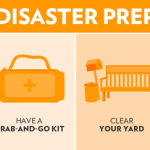By: Deidre Sullivan House Logic
When stuff hits the fan and you need to flee your home, being organized is the best way to protect your home and family.
If there comes a time when you have to abandon your house, an emergency probably won’t give you enough time to gather essentials and take steps to limit property damage. Getting all of your ducks in a row before disaster strikes is the best course of action.
How to Get Ready Now
Evacuations in the U.S. are more common than most people realize, according to FEMA. Natural disasters aside, people are forced to leave their homes hundreds of time a year because of transportation and industrial accidents.
Here’s a list of things you can prepare now in case your home is ever in harm’s way:
- Have a grab-and-go kit. Include essential supplies, such as water, food, and first-aid supplies.
- Have copies of important papers. Keep these in a plastic, waterproof case. FYI, this stuff is priceless, because you may need to prove who you are and that you own your house. Include:
- Your driver’s license.
- The deed to your house.
- Proof of insurance.
- Medical records.
- Passports.
- Social security cards.
- A list of personal contacts.
- Safeguard pets. Make sure they’re micro-chipped and have I.D. collars. Create pet grab-and-go kits that include leashes, medications, meal bowls, and three days worth of food and water.
- Prep your yard. Maintain your trees and shrubs so diseased or weakened branches won’t fall down and damage your property.
- Know your utility shutoffs. Learn now how to safely shut off all utility services in your home. FEMA has tips for shutting off electricity, water, and gas. Note: To turn off gas you may need a special wrench.
- Stockpile sandbag materials. If you live in a flood prone area, keep sandbags on hand or the materials to make them. It takes 100 sandbags to create a 1-foot-tall wall that’s 20 feet long. If you’re filling bags on the fly, two adults can create the wall in about an hour.
- Protect windows. If you live in an area susceptible to hurricanes, install shutters that are rated to provide protection from windblown debris.
When It’s Time to Evacuate
Before you pick up and go (and if you have enough time) follow these steps — they’re designed to protect your pets and help prevent property damage:
- Clear your yard. Remove any objects hanging on trees or your home’s exterior, such as birdhouses and wind chimes — they can break off in high winds and cause serious damage. Bring inside anything that’s not nailed down including lawn furniture, trashcans, toys, and garden equipment.
- Shut off utilities. Turn off electricity, water, and gas. Doing so will help prevent additional dangers including flooding, fire, and explosions. Keep in mind, you’re going to need the utility company to turn your gas back on when you return home.
- Windproof windows and doors. If you don’t have storm-proof shutters, fit plywood coverings over all windows. (FYI, using just tape on windows is not recommended because it will not stop windows from breaking, just shattering.)
- Protect indoor stuff. Move valuables to higher levels in your home to prevent water damage. As an extra measure, wrap electronics and furniture in sheets, blankets, or plastic drop cloths.
- Gather up pets. If it’s not safe for you to stay, it’s not safe for Fido. Make plans to stay with friends or at a pet-friendly hotel — most emergency shelters will only accept service animals that assist people with disabilities.
- Lock your house. Because crooks and looters take advantage of evacuations, lock all doors and windows and don’t leave house keys in an obvious place, such as a mailbox.
Important Stuff to Remember
Whether the order is voluntary or mandatory, if officials in your area tell you to evacuate, you should do so before things get worse. Although laws vary from area to area, you may receive a hefty fine or face a jail sentence if you don’t follow a mandatory evacuation order.
Failure to follow an evacuation order can place your life in danger by leaving you stranded in an area with no basic services or food and water.
When you return home after an emergency, don’t use matches, lighters, or any sources of flame or spark until you’re 100% certain that you don’t have a natural gas leak inside your home — you’ll need a gas company service technician to confirm that it’s safe.
Stay Informed with Emergency Alerts
Smartphone technology has made it easier to receive disaster alerts free of charge. You’ll automatically receive alerts if you have a phone capable of receiving Wireless Emergency Alerts (WEA) and your wireless carrier participates in the program. To find out if your mobile device is capable of receiving WEA alerts, contact your mobile device carrier or visit CTIA – The Wireless Association.
183 MINE RIDGE ROAD ON LAKE MARTIN ALABAMA
5 BEDROOM : 4 FULL BATH : 2 HALF BATH
Fabulous house, fabulous views in fabulous gated community. 3 car garage,covered boathouse, covered outdoor area with stone fireplace. Gated community with pool and tennis courts.
By: Dave Toht
Contrary to popular belief, there aren’t any health benefits linked to cleaning air ducts, but having a pro remove gunk can boost the efficiency of your HVAC.
Five to seven times a day, the air in your home circulates through the air ducts of your HVAC heating and cooling system, carrying with it the dust and debris of everyday living.
Your furnace filter catches much of the stuff, but neglect, remodeling projects, or shoddy duct installation can lead to a buildup of gunk inside your ductwork that threatens the efficiency of your system.
Are Dirty Ducts Hazardous to Your Health?
The Environmental Protection Agency (EPA) asserts no studies have proven that duct cleaning prevents health problems. Also, there isn’t proof that dirty ductwork increases dust levels inside homes.
But some people are more sensitive to airborne dust and pet dander than others. If your nose is getting itchy just thinking about what might lurk in your ducts, the $300 to $600 it costs to clean a 2,000-square-foot home is a worthwhile investment. But before you reach for the phone, take a good look to see if your ducts are dirty.
Get the Picture
Wouldn’t it be handy if you could take an incredible journey through your ductwork to see if cleaning is needed? Using a pocket digital camera equipped with a flash, you can come close. Simply remove a floor register, reach as far as you can into the duct (don’t drop your camera!), and take a couple of shots.
If there’s gunk within a few feet of the register, take heart. It’s easy to snake a vacuum cleaner hose into the duct and remove the stuff. However, if you see a long trail of junk and a thick coat of dust beyond what your vacuum can reach, your house may be a candidate for professional cleaning.
Look for These Symptoms
- Clogs of dust, cobwebs, and debris, or noticeable particles blowing out of supply registers
- Visible mold on the inside surfaces of ducts
- Rodent droppings and dead insects inside ducts
In addition, recent construction inevitably creates dust you don’t want in circulation.
“We recommend cleaning after a big remodel job,” says Scott Milas of Mendel Heating and Plumbing, St. Charles, Ill. Milas adds that a new home purchase is also a good occasion — after all, who wants to breathe someone else’s pet dander?
“People get it done after they buy a house,” he says. “It’s like getting the carpets cleaned.”
Good Reasons for Duct Cleaning
- Cleaning removes accumulated dust so it won’t shed into the household.
- Removing debris and cobwebs eases airflow and increases the efficiency of the system, in extreme cases as much as 40%.
- If you have fiberglass ducting, fiberglass gathers more dust than sheet metal.
Reasons to Skip Duct Cleaning
- Cost.
- Health benefits are not proven.
- Dust and debris caught on the interior of ducts isn’t circulating and therefore may not be a problem.
- Changing furnace filters regularly often does the job, especially when combined with annual furnace cleaning.
By: Credit.com
One of the best ways to eliminate your mortgage debt is moving into a 15-year fixed-rate loan. With the average spread a full 1% compared to its 30-year counterpart, a 15-year mortgage can provide an increased rate of acceleration in paying off the biggest obligation of your life.
Can you pull it off?
In most cases, you’re going to need strong income for an approval. How much income? The old 2:1 rule applies. Switching from a 30-year mortgage to a 15-year fixed-rate loan means you’ll pay down the loan in half the amount of time, but it effectively doubles up your payment for each month of the 180-month term. Your income must support all the carrying costs associated with your home including the principal and interest payment, taxes, insurance, (private mortgage insurance, only if applicable) and any other associated carrying cost. In addition, your income will also need to support all the other consumer obligations you might have as well including cars, boats, installment loans, personal loans and any other credit obligations that contain a monthly payment.
The attractiveness of a 15-year mortgage in today’s interest rate environment has mass appeal. The 1% spread in interest rate between the 30-year mortgage and a 15-year mortgage is absolutely real and for many, the thought of being mortgage-free can be very tempting. Consider today’s average 30-year mortgage rate of around 4% on a loan of $400,000—that’s $287,487 in interest paid over 360 months. Comparing that to a 15-year mortgage over 180 months, you’ll pay a mere $97,218 in interest. That’s a shattering savings of $190,268 in interest, but there’s a catch—your monthly mortgage payment is going to be significantly higher.
Here’s how it breaks down. The 30-year mortgage in our case study pencils out to a $1,909 monthly payment covering principal and interest. Weigh that against the 15-year version of that loan, which comes to $2,762 a month in principal and interest, totaling $853 more per month, but going to principal. This is why the income piece makes or breaks the 15-year deal. Independent of your other carrying costs and other credit obligations, you’ll need to be able to show an income of $4,242 a month to offset just a principled interest payment on the 30-year fixed-rate mortgage. Alternatively, to offset the principled interest payment on the 15-year mortgage, you would need an income of $6,137 per month, essentially $1,895 per month more in income, just to be able to pay off your debt faster. As you can see, income is a large driver of debt reduction potential.
What to do if your income isn’t high enough
When your lender looks at your monthly income to qualify you for a 15-year fixed-rate loan, part of the equation is your debt load.
Lenders are going to consider the minimum payments you have on all other credit obligations in the following way. Take your total proposed new 15-year mortgage payment and add that number to the minimum payments on all of your consumer obligations and then take that number and divide it by 0.45. This is the income that you’ll need at minimum to offset a 15-year mortgage. Paying off debt can very easily reduce the amount of income you might need and/or the size of the loan you might need as there would be fewer consumer obligations handcuffing your income that could otherwise be used toward supporting a stable mortgage plan.
Can you borrow less?
Borrowing less money is a guaranteed way to keep a lid on your monthly outflow maintaining a healthy alignment with your income, housing and living expenses. Extra cash in the bank? If you have extra cash in the bank beyond your savings reserves that you don’t need for any immediate purpose, using these funds to reduce your mortgage amount could pencil very nicely in reducing the 15-year mortgage payment and interest expense paid over the life of the loan. The concept of the 15-year mortgage is “I’m going to have to hammer, bite, chew and claw my way through a higher mortgage payment in the short term in order for a brighter future.”
Can you generate cash?
If you can’t borrow less, generating cash to do so may open another door. Can you sell an asset such as stocks, or trade out of a money-market fund in order to generate the cash to rid yourself of debt faster? If yes, this is another avenue to explore.
You may also want to explore getting additional funds via selling another property. If you have another property that you’ve been planning to sell such as a previous home, any additional cash proceeds generated by selling that property (depending upon any indebtedness associated with that property) could allow you to borrow less when moving into a 15-year mortgage.
Are you an ideal match for a 15-year mortgage?
Consumers who are in a financial position to handle a higher loan payment while continuing to save money and grow their savings would be well-suited for a 15-year mortgage. The other school of thought is to refinance into a 30-year mortgage and then simply make a larger payment like you would on a 25-year, 20-year or 15-year mortgage every month. This is another fantastic way to save substantial interest over the term of the loan, since the larger-than-anticipated monthly payment you make to your lender will go to principal and you’ll owe less money in interest over the full life of the loan. As cash flow changes, so could the payments made to the loan servicer, as prepayment penalties are virtually nonexistent on bank loans.
There is an important “catch” to taking out a 15-year mortgage—you also decrease your mortgage interest tax deduction benefit. However, if you don’t need the deduction in 15 years anyway, the additional deduction removal may not be beneficial (depending on your tax situation and future income potential).
If your income is poised to rise in the future and/or your debt is planned to decrease and you want to have comfort in knowing by the time your small kids are teenagers that you’ll be mortgage-free, then a 15-year loan could be a smart move. And when your mortgage is paid off, you’ll have control of all of your income again as well.
Proximity to retirement is another factor borrowers should consider when carrying a mortgage into retirement isn’t ideal. These consumers might opt to move into a faster mortgage payoff plan than someone buying a house for the first time.
Keep in mind that to qualify for the best interest rates on a mortgage (which will have a big impact on your monthly payment), you need a great credit score as well. You can check your credit scores for free on Credit.com every month, and you can get your free annual credit reports at AnnualCreditReport.com, too.
This article was written by Scott Sheldon and originally published on Credit.com.





